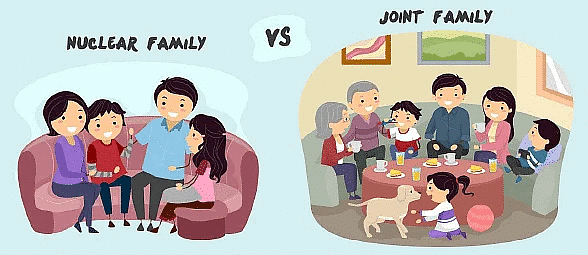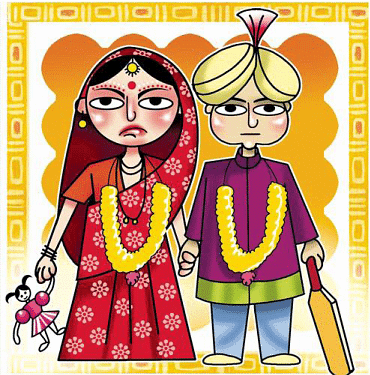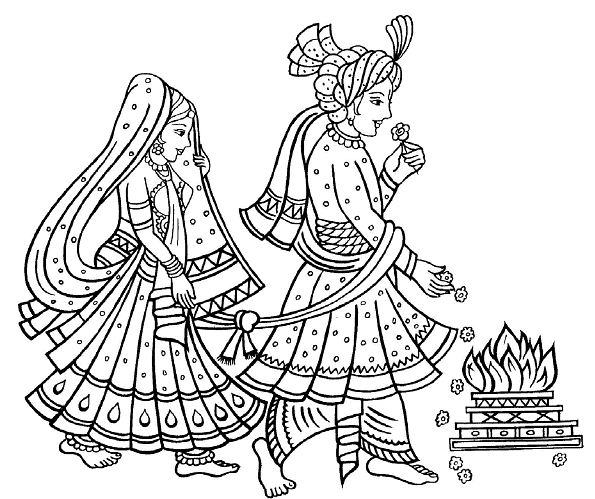Family and Marriage in India | Sociology Optional for UPSC (Notes) PDF Download
Desai's study focuses on the concept of jointness within families in the small town of Mahuva, Gujarat. Jointness refers to the degree to which family members are connected, both in terms of household structure and the performance of functions and obligations for one another. Desai's research examines factors such as religion, occupation, property, education, urbanization, and kinship obligations in relation to jointness.
According to Desai, a family can transition between being a nuclear and a joint family. A nuclear family consists of a married couple and their unmarried children, while a joint family includes additional generations and relatives living together. This change in family structure can be caused by natural reasons, such as marriage or the death of parents, or circumstantial reasons, such as relatives moving away or the head of the family leaving for business purposes.
Desai identifies five degrees of jointness:
- Households with zero degree of jointness.
- Households of low degree of jointness (joint based on the fulfillment of mutual obligations).
- Households with a high degree of jointness (jointness based on common ownership of property).
- Households of the highest degree of jointness (traditional joint families).

In Mahuva, Desai found that 61% of families were structurally nuclear and 39% were joint, with varying degrees of jointness. Only 5% of the families studied were not joint at all. Despite this, a majority of the respondents expressed a belief in the joint family system, even if they were unable to live in such a family due to circumstances beyond their control.
- Family dynamics in India are complex and multidimensional, influenced by factors such as age, sex, kinship status, education, occupation, and social standing. The extended joint family acts as a microcosm of the larger social system, reflecting its values and norms. Jointness in functional terms can be understood as the structure of obligations among close kin.
- Desai's study highlights that higher education and upper castes are more likely to be associated with joint families, suggesting that the joint family system is not weakened by education. In conclusion, Desai's research reveals that while many families in Mahuva may be structurally nuclear, they continue to maintain a sense of jointness through the performance of functions and obligations for one another.
Changing Structure and Functions of Family
The institution of family has been undergoing significant changes all over the world. These changes are driven by factors such as industrialization, urbanization, and the development of material culture. In India, the changes in family structure and functions are taking place gradually, but they are still significant.- The main change in family structure is the reduction in family size, with nuclear families becoming more common. This is due to the migration of rural people to cities, driven by industrialization and urbanization. The emotional bonds within families are also becoming weaker, leading to a rise in divorce rates and single-member households.
- Family functions have evolved as well. In the past, families were units of production, with all members contributing to a shared occupation. Industrialization has displaced the household production system, with people shifting away from their family occupations and becoming less dependent on their families.
- Legislation has played a significant role in bringing about changes in marriage and family life in India. Laws have been enacted to address issues such as minimum age for marriage, mate selection, number of spouses, divorce, dowry, and remarriage. These laws have helped in eradicating inhuman practices like Sati, promoting widow remarriage, and discouraging child marriages.
- Legislation has also influenced family life by providing equal rights to all members, including women, in matters of inheritance, marriage, divorce, and property. Laws protecting the economic interests of women and preventing their exploitation have also been enacted. These legislative changes have contributed to a gradual transformation of the traditional patriarchal family system in India.
 Child marriage is becoming less prevalent in Indian society due to legislation and awareness campaigns
Child marriage is becoming less prevalent in Indian society due to legislation and awareness campaigns
In conclusion, the changes in the structure and functions of family in India are driven by factors such as industrialization, urbanization, and legislation. While these changes are gradual, they are significant and have far-reaching implications for the institution of family in India.
Marriage in India
Marriage Among Hindus
Marriage in India, particularly among Hindus, holds a unique and sacred significance. It is not only a union between a man and a woman sanctioned by society but also a means to advance their spiritual development. Sociologists recognize the relative stability of marriage relationships in India and emphasize the multiple aims and various forms of marriage among Hindus.
 There are multiple aims and various forms of marriage amongst Hindus
There are multiple aims and various forms of marriage amongst Hindus
- The primary aims of Hindu marriage include fulfilling religious obligations, practicing dharma, procreation, and sexual pleasure. Marriage is considered a sacrament, and it is essential for a Hindu to be married to fulfill religious duties and repay the three religious debts of Pitri Rin, Daiv Rin, and Guru Rin. A wife plays a crucial role in the completion of Grihasth Dharma and performing religious rites.
- Hindu scriptures describe eight forms of marriage, including Brahm Vivah, Daiv Vivah, Arsh Vivah, Prajapatya Vivah, Asur Vivah, Gandharv Vivah, Rakshas Vivah, and Paisach Vivah. Each form varies in terms of rituals, rules, and social acceptability.
- Mate selection in Hindu marriages is governed by endogamous and exogamous rules. Endogamy prescribes marriage within one's own caste or sub-caste, while exogamy requires one to marry outside their own group. Sagotra exogamy forbids marriage between persons with the same gotra, while Sapind exogamy prohibits marriage between blood relatives up to five generations on the mother's side and seven generations on the father's side.
- Other rules of marriage include hypergamy or Anuloma, where the ritual status of a man is higher than that of his prospective wife, and hypogamy or Pratiloma, where the ritual status of a woman is higher than that of her prospective husband. Intercaste marriages have been legalized through various legislations such as the Special Marriage Act 1954, Hindu Marriage Act 1955, and Hindu Marriage Laws (Amendment) Act 1976.
Marriage Among Muslims
Muslim marriage, or Nikah, is considered both a social contract and a civil contract. Though it is also a religious affair in India, the concept of marriage as a relatively permanent bond between a man and a woman is a shared heritage between Indian culture and Muslim marriages. In India, Muslim marriages are known to be more stable than those in the Arab world and other places. The two main sects among the Muslim community in India are the Shias and the Sunnis, and while there might be differences in rituals between them, the essential features of all Muslim marriages (Nikah) remain the same.Four parties are recognized as valid in a Muslim marriage under Muslim Personal Law:
- The groom
- The bride
- The Kazi (officiant)
- Witnesses (two males or four females)
The Kazi formally asks the bride and groom for their voluntary consent to the marriage in the presence of the local community and chosen witnesses. If both parties agree, the marriage contract, or Nikahnama, is sanctioned. This contract includes the amount of Mehr, or bridewealth, that the groom must give to the bride either at the time of the marriage or later, as agreed upon.
Marriage ceremonies typically take place at the bride's home among both Hindus and Muslims in India. Many customs are shared between Hindus and Muslims in specific regions. For example, the Hindu rite of Kalyanam is an essential component of the traditional Nikah among the Moplah Muslims of Kerala. Parallel cousin marriage, or the marriage of one with the daughter/son of one's father's brother, is preferred among Muslims. Additionally, widow remarriage is not an issue among Muslims.
Muslim marriages can be classified into two types: regular (Sahi) and irregular (Fasid). Irregular marriages occur in the following cases:
- Absence of witnesses during the proposal and acceptance.
- A man's fifth marriage.
- A woman's marriage during the period of Iddat, which lasts three months for a divorcee and four months and ten days for a widow to ensure she is not pregnant.
- Difference in religion between the wife and husband.
Marriage Among Christians
Christian marriages, like Hindu and Muslim marriages, are also stratified and divided into groups such as Protestants, Catholics, Latin, and Syrian Christians. The main objectives of Christian marriages are to obtain social sanction for sex relations and procreation, to follow religious beliefs, and to ensure mutual help and comfort. Marriage partners are usually selected by parents, and various formalities are fulfilled before the marriage, such as producing a character certificate and submitting an application for marriage in the church. Christian marriages do not permit polygyny and polyandry, and remarriage of widows is accepted and encouraged.- Selection of Marriage Partners: Parents typically select marriage partners for their children, with a focus on avoiding blood relations and considering factors such as social status, character, education, and physical fitness.
- Marriage Formalities: After the engagement ceremony, a character certificate is produced, and an application for marriage is submitted to the church three weeks before the due date. The church priest then invites objections against the proposed marriage, and when no objection is received, the marriage date is fixed.
- Marriage Ceremony: The marriage is solemnized in the church, with the couple declaring that they take each other as wedded partners in the presence of two witnesses and in the name of Lord Christ.
- Christian Marriage Laws: The Indian Christian Marriage Act 1872, which has been amended several times, covers all aspects of marriage. Christians practice divorce, although the church does not appreciate it. The Indian Divorce Act, 1869, refers to the conditions under which divorce may be obtained.
- Need for Law Reforms: There is a need for reform in the Divorce Act of Christians, as it is outdated and gender discriminative. The law encourages perjury, collusion, and maneuvering, and Christians need a law that caters to the changing needs of the times. The Law Commission had formulated the Christian Marriage and Matrimonial clauses Bill in 1960, but it was allowed to lapse. In 1994, the Joint Women's Programmes (JWP) drafted the Christian Marriage Matrimonial clauses Bill and Christian Maintenance Bill, but no measures were taken to get them passed.
Marriage Among Tribal People
Marriage customs among tribal people in India are diverse and unique, with various tribes having their own rules and preferences for mate selection. Despite allowing premarital and extramarital relations during festive occasions, most tribes enforce strict monogamous relationships. Mate selection preferences vary from tribe to tribe, with some preferring cross-cousin marriages to keep property intact and avoid bride price negotiations. Monogamous marriages are widely accepted, while polygamous marriages, including polygyny and polyandry, are practiced by some tribes. There are several ways of acquiring mates in tribal communities, such as marriage by probation, capture, trial, purchase, service, exchange, elopement, and intrusion.- Preference in Mate Selection: Tribes have their own rules and preferences for choosing a spouse, with some opting for cross-cousin marriages to maintain property within the family.
- Types of Marriages: Monogamy is widely practiced, while polygamy, including polygyny and polyandry, is prevalent in certain tribes.
- Ways of Acquiring Mates: Tribal communities follow various methods for acquiring mates, including marriage by probation, capture, trial, purchase, service, exchange, elopement, and intrusion.
Conclusion
Marriage in India varies significantly across different religious and cultural groups, including Hindus, Muslims, Christians, and tribal people. Each group has its own unique customs, rituals, and laws governing mate selection, marriage ceremonies, and family structures. While there are some shared customs and objectives, such as social sanction for sex relations and procreation, the diversity in marriage practices highlights the rich cultural heritage of India. As society evolves, there is a need for law reforms to address outdated and gender-discriminative practices in some communities, ensuring that the institution of marriage remains relevant and adaptable to the changing times.Frequently Asked Questions (FAQs) of Family and Marriage in India
What is the concept of jointness in families, as studied by Desai?
Jointness refers to the degree to which family members are connected, both in terms of household structure and the performance of functions and obligations for one another. Desai's research examines factors such as religion, occupation, property, education, urbanization, and kinship obligations in relation to jointness.
What are the primary aims of Hindu marriage?
The primary aims of Hindu marriage include fulfilling religious obligations, practicing dharma, procreation, and sexual pleasure. Marriage is considered a sacrament, and it is essential for a Hindu to be married to fulfill religious duties and repay the three religious debts of Pitri Rin, Daiv Rin, and Guru Rin.
How does Muslim marriage, or Nikah, differ from Hindu marriage?
Muslim marriage, or Nikah, is considered both a social contract and a civil contract. While it is also a religious affair in India, it is different from Hindu marriage in terms of the marriage contract, or Nikahnama, which includes the amount of Mehr, or bridewealth, that the groom must give to the bride either at the time of the marriage or later, as agreed upon.
What are the main objectives of Christian marriages in India?
The main objectives of Christian marriages are to obtain social sanction for sex relations and procreation, to follow religious beliefs, and to ensure mutual help and comfort. Christian marriages do not permit polygyny and polyandry, and remarriage of widows is accepted and encouraged.
How do the marriage customs among tribal people in India differ from those of other communities?
Marriage customs among tribal people in India are diverse and unique, with various tribes having their own rules and preferences for mate selection. Despite allowing premarital and extramarital relations during festive occasions, most tribes enforce strict monogamous relationships. Mate selection preferences vary from tribe to tribe, and there are several ways of acquiring mates in tribal communities, such as marriage by probation, capture, trial, purchase, service, exchange, elopement, and intrusion.
|
120 videos|427 docs
|
















